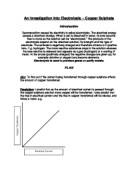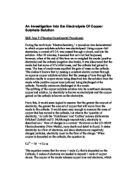Apparatus: Power pack, 2 leads, 1 carbon electrode, 4 Beakers, measuring cylinder, 0.5M solutions of: 20mL Copper II Chloride, 20mL Aluminium Nitrate, 20mL Zinc Sulfate, 20mL Nickel Sulfate and 50mL Potassium Nitrate. Strip of copper, aluminium, zinc and nickel, digital scales
Method:
The experiment was divided into two parts, Part A, the control experiment in each stage and Part B, where the variable (Potassium Nitrate) was added.
Before beginning part A, the metal to be placed as the anode was weighed and this measurement recorded. The circuit was then connected as above, using the metals’ corresponding solution, for example Nickel anode with Nickel Sulfate solution. The voltage was set to six volts on the power pack and circuit switched on for 120 seconds. During this time, observations of reactions were made and connecting wires held to keep electrodes the same distance apart. Once the power was switched off, the anode was wiped with towel to clear of excess solution before being weighed once more. The cathode was cleaned of any deposit using paper towel.
The metal salt solution from part A, 10mL Potassium Nitrate solution was now added and Part B was set up as seen below. The anode was the same metal strip previously used in part A. The technique of part A was repeated, with the circuit being switched on for 120 seconds on six volts of power. Observations were made and electrodes kept the same distance apart, on opposite sides of the same sized beaker. The wiped anode was weighed after the completion of the experiment and cathode cleaned of any precipitate.
The experiment was completed for Copper, Nickel, Zinc and Aluminium, and their respective aqueous solutions.
Results:
Calculations:
Discussion:
This experiment demonstrated the competing electrode reactions in an electrolytic cell and how the introduction of further ions, in the potassium nitrate, changes these reactions further. In doing so, in every part b, where Potassium Nitrate is added to solution, a series of reactions takes place in conjunction with the reduction and oxidation reactions at the electrodes to produce both a precipitate and the continuation of the normal electroplating reaction.
Our experiment was designed to be both qualitative and quantitative, based on both observation and measurements so as to provide more accurate analysis of the resulting reactions. As we were using such small amounts of substance, more emphasis should be placed on the observations rather than the measurements we attempted as their accuracy is unknown.
The quantitative results confirm that the metal was electroplated in part A of stages 1 and 2. As the metal decreased in weight, our qualitative results see the build up of the metal on the carbon cathode, confirming that the metal was being electroplated onto the cathode. It would have been useful to have more accurate measurements so that comparisons regarding the amount of substance produced at a given voltage and time could have been made. As the weight increases are so small in the part B’s of the experiment, this could be simply attributed to measurement error. The notable weight gain in stage 4a is unforeseen in my calculations and I attribute this to measurement error and rushed experimental technique.
To increase the accuracy of the quantitative results, both the anode and the cathode should have been weighed, to demonstrate that the oxidation and reduction reactions both involved the metal and thus electroplating was taking place. The amount of metal or time taken to do the experiment could have been increased to increase the accuracy of the observed changes.
The qualitative results demonstrate the idea that the Potassium Nitrate solution, as it contains ions which are always soluble in the substances of the experiment, will provide extra ions in solution and causing the cell to react differently through the products that can now be produced with the ions. We can compare these results with those of the normal electroplating cell to see the difference Potassium Nitrate has made.
The introduction of further ions into solution added to the possible reactions that could take place at the electrodes. The difference between all of section B of each stage and their corresponding section A was that a precipitate of some kind was formed, rather than simply a normal electroplating reaction demonstrated by a deposit on the cathode. In Stage 1b, both a bronze deposit of copper was found on the electrode and a precipitate was observed in the solution, giving the idea that copper was being oxidized and ions where coming into solution and then being reduced on the cathode, as in a normal electroplating cell. However, a black precipitate in the solution and the solution fading in colour of blue were observed. I speculate that this precipitate is Copper Oxide, a black insoluble solid caused by a reaction between the oxygen produced by the oxidation of water at the anode and the copper ions in solution.
This is demonstrated in the equation below: 2Cu2+(aq) + O2 (g) → 2CuO (s)
As stated, to produce this reaction, and thus the precipitate, oxidation of water must have taken rather than the calculated more favourable reaction, oxidation of the metal. This could be attributed to the greater volume of solution there now is and thus greater amount of water molecules to be oxidized. The fading of the solution suggests that the copper was not oxidizing and replacing the ions of the copper chloride solution being plated on the cathode and those combining with oxygen gas to form Copper Oxide. This leads to the disproving the idea that more than one redox reaction can take place at an electrode, as the adding of potassium nitrate simply changes the concentration of ions available to react and changes the reaction which is more likely to take place, rather than causing more than one redox reaction to take place at once.
Further analysis of the precipitates produced by part b would have provided us with further information as to the reactions taking place and thus information on whether more than one redox reaction can take place on the electrode.
Lesser reactivity of metals produce faster reactions.
Both Zinc and Nickel are considered to be more reactive than copper in the reactivity series and will normally displace copper from solution. However, in these electrolytic cell, our qualitative observations indicate that the copper electroplating reaction is faster than the nickel or zinc electroplating reactions as there is more copper seen to be observed on the carbon cathode. As copper has a greater rate of reaction, one can postulate that if larger time intervals were using, this experiment could confirm the relative activity of some of the metals in the reactivity series as the electricity in the circuit reverses the metal displacement reactions that would normally take place.
In this experiment, we maintained variables to give focus to the experiment, with our primary variable being part b’s adding of Potassium Nitrate to the control experiment of part A. However, through part b having a greater volume and the beaker remaining the same, greater surface area of the metal was in contact with solution. As a result of the greater volume of solution in part B of each section may have increased the rate of reaction but further quantative analysis at time intervals would have been needed to prove this. We maintained variables such as time, voltage, distance between electrodes, surface area of each metal touched by solution in each part and volume, with 10mL of each solution being used.
In restricting the variables, we focused on the affect of concentration of ions on the electrolysis reaction. However to investigate other variables the suggested experiments below could be undertaken. To investigate the affect of surface area on the reactions which take place, differently sized pieces of metals could be used and the reactions observed quantitatively and qualitatively.
To further confirm Faraday’s laws, that is that the amount of substance produced at each electrode is directly proportional to the quantity of charge, one could place a variable resistor and an ammeter in the circuit and measure the amount of metal deposited at cathode in mols against the charge in the circuit. By varying the voltage, the idea that the greater the voltage, the greater the charge on the electrodes and so thus the greater the attraction for ions and the greater the current flow would be demonstrated in this greater current flow being measured through the amount of metal deposited at the cathode.
To confirm Faraday’s laws qualitatively, one could observe the quality of the electroplating on the cathode, as metals plated at a certain current density might form a durable and shiny coating on the cathode, while some other current density might form an excessively grainy, dull coating. A higher potential difference (voltage) applied to the cell means the cathode will have more energy to bring about reduction, and the anode will have more energy to bring about oxidation. Higher potential difference would enable the electrolytic cell to oxidize and reduce energetically more "difficult" compounds. This may drastically change what products will form in this experiment. These could be qualitatively observed.
The distance between the electrodes of the experiment was kept constant, however to investigate the affect of this one could have a constant such as stage 1a and then vary the distance between electrodes and calculate the difference in rate of reaction by measuring the amount of product formed in the same period of time. It could be hypothesized that the greater the distance between electrodes means that the average time for ions to reach them is greater so the electron flow through the wires is less.
This experiment demonstrated the competing electrode reactions and how the concentration of ions influences the redox half reactions that take place at the anode or cathode. It also demonstrated that less active metals, according to the reactivity series, have higher rates of reactions in electroplating electrolytic cells. Further investigation of variables influencing electrolytic cells through suggested experiments, greater care taken in measurements and greater amount of reactants used would make the experiment more successful.







